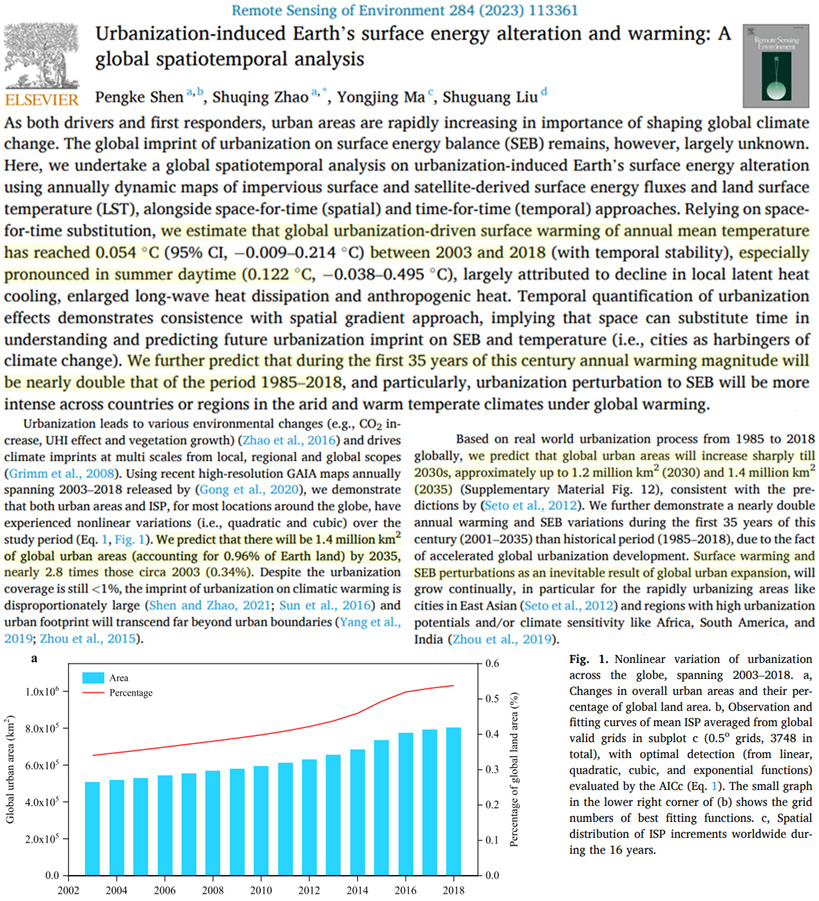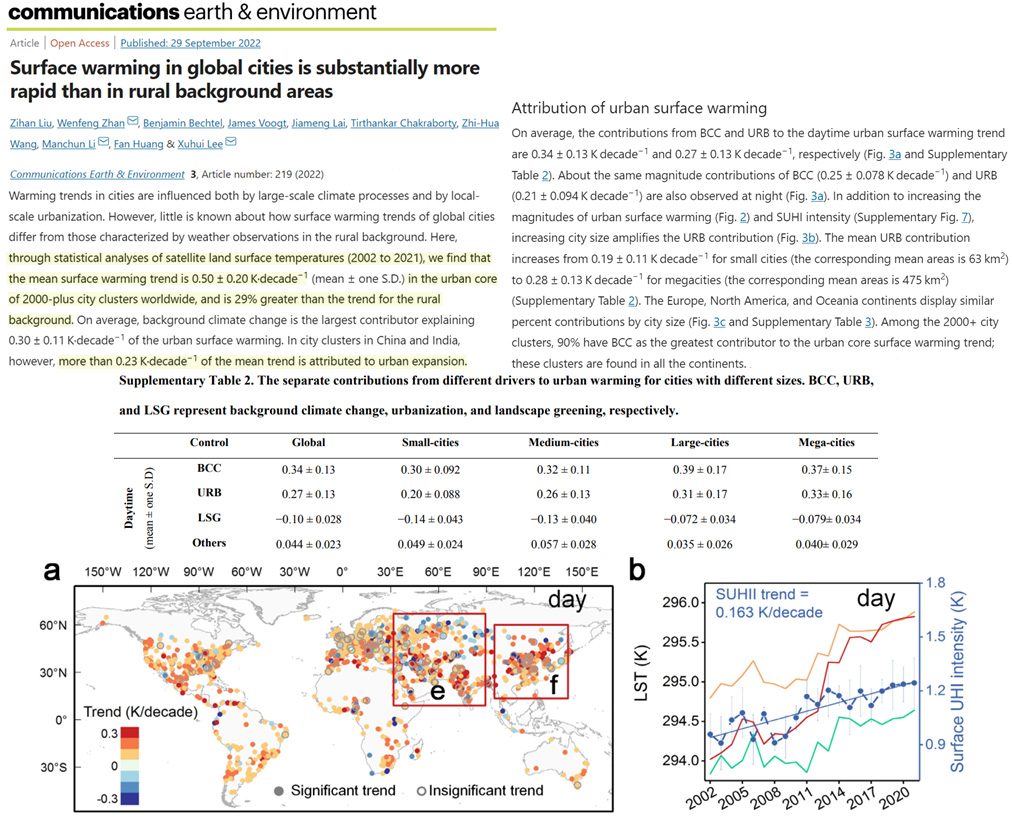Two new studies affirm the rapid growth in urbanization is causing significant non-climatic warming, artificially increasing the “global” trend.
Water covers approximately 362 million km² of the Earth’s surface. Land covers 148 million km² of the Earth’s surface.
As of 2003, just 0.5 million km² (0.34%) of the globe’s 510 million km² surface was urban or mostly urban. As of 2018, it was 0.7 million km² (0.42%). By 2035, 1.4 million km² (0.96%) of the Earth’s surface will be urban.
So approximately 99.8% of the Earth’s surface is not urban, and yet the majority of the temperature stations contributing to the “global” warming trend records over the last decades are located in urban areas. This would appear to have a tendency to bias the warming trends.
Urbanization adds artificial, non-climatic warmth
A new study assesses urbanization (concrete, machinery, roofs, vehicles, etc.) added 0.054°C of additional warmth to the annual temperature over the 16 years from 2003 to 2018. In summer, as much as 0.122°C was added to global temperature records over this period.
Urban areas are poised to experience rapid growth in the next two decades, almost tripling the proportion of the surface area (from 0.34% to 0.96%) during the 2003-2035 period.
This explosive expansion in global urban area is predicted to “nearly double” the growth in artificial, non-climatic warming added to the surface temperature record from densely populated areas.
Since the majority of the globe’s temperature stations are situated in urban areas, this urbanization tendency is poised to inflate temperature records well beyond that of non-urban areas.

Image Source: Shen et al., 2023
Another new study assesses the mean surface warming trend as 0.5 ± 0.20 K·decade−1 in the urban core of more than 2000 city clusters across the globe. This is “29% greater than the trend for the rural background.”
In other words, “surface warming in global cities is substantially more rapid than in rural background areas.”






The whole debate about global warming is just as ridiculous as that so-called theological question about how many angels you can get on the head of a pin.
Most places on this planet experience a daily variation in the range of temperatures, sometimes up to 15 deg. C, as here in Perth.Temperature is never constant. It rises and falls with the time of day, weather and season. Who, then, can truthfully say that they have noticed an overall global warming of 1 deg. C.?
And what difference does a theoretical rise in temperature make when temperature fluctuates every day? I suppose that if you get paid good money for debating pointless philosophical questions – global warming, that is – then you are going to make the most of it, even if your conclusions are rubbish.
When it comes to UHI I have seen it on the thermometer in my car. I live in the country outside London and travel into the southern suburbs on occasion and have seen a temperature fall of 5C over a journey of 45 minutes. I also live not far from Gatwick Airport and on one frosty night – well it was at my house – I drove to a retail area beside the airport and on getting back into my car noticed it was 3C. I watched it as I drove home and saw it drop down to -1C at my house. Now how many weatherstations at airports are included in the temperature records? How often in the UK are we subjected to high temperatures being seen at Heathrow Airport? And the alleged highest UK temperature evah was recorded for ONE second next to the runway at RAF Coningsby.
“Because of the “urban heat island” effect, cities of a million or more people can be 1–3°C (1.8–5.4°F) warmer on average—and as much as 12°C (22°F) warmer in the evening—than the surrounding area, according to the U.S. Environmental Protection Agency.”
I don’t dispute their conclusions, but when people make claims about temperature changes of hundredths of a degree amid dynamic ranges orders of magnitude bigger, I do somewhat question their methods.
When my wife and I are watching our local Kansas City weather forecast, I consistently predict that Lawrence will have the highest daily temp. I’m always right. The Lawrence weather station is at the airport…surrounded by tarmac.
“In other words, “surface warming in global cities is substantially more rapid than in rural background areas.”
Well who knew???
“Urban areas are poised to experience rapid growth in the next two decades,…”
This assumption is likely wrong. It is claiming “surface area” and not height and population. Some places are over-built — think China’s zombie cities, or the issues that NYC and San Francisco have. The work-from-anyplace has made many buildings under-utilized. The mayor of SF just announced “Roadmap to Downtown San Francisco’s Future” that includes a mix of tax incentives and other actions to increase residential occupation of old office buildings. Further, many cities have lots of space — think open air parking spaces. Old shopping malls are struggling, and some are being converted to new uses (‘sequent occupance’ is a studied topic). The large parking areas around these facilities can and will be developed into 3-D spaces.
https://www.webbaviation.co.uk/aerial/_data/i/galleries/South_Yorkshire/Sheffield/Meadowhall_shopping_centre_Sheffield_ba06334-me.jpg
Years ago the BBC (ironically) produced a program about a Victorian walled garden. The Victorians were able to grow peach trees against the northern wall as it faced the sun all day; some even had little fireplaces to keep the brick wall warm. The presenter ran an experiment with 3 thermometers; one at the north wall, one in the middle and one at the south wall. The difference in temperatures was astonishing, something like 5 degrees, just across one garden.
[…] https://notrickszone.com/2023/02/13/in-2003-the-globe-was-0-34-urban-by-2035-0-96-will-be-global-war… […]
A question: Can anyone tell me whether energy inputs from burning transportation fuels, heating and lighting homes, fans, clothes dryers, kitchen stoves, etc., are included in these urban effects calculations?
This was misposted elsewhere.
[…] In 2003 The Globe Was 0.34% Urban. By 2035 0.96% Will Be. ‘Global’ Warming Is Significantly Urba… […]